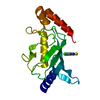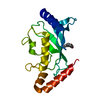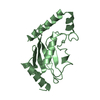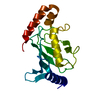+ Open data
Open data
- Basic information
Basic information
| Entry | Database: PDB / ID: 1a3s | ||||||
|---|---|---|---|---|---|---|---|
| Title | HUMAN UBC9 | ||||||
 Components Components | UBC9 UBE2I UBE2I | ||||||
 Keywords Keywords | SUMO CONJUGATING ENZYME / UBIQUITIN CONJUGATING ENZYME | ||||||
| Function / homology |  Function and homology information Function and homology informationpositive regulation of SUMO transferase activity / SUMO conjugating enzyme activity / RING-like zinc finger domain binding / SUMO ligase complex / SUMOylation of nuclear envelope proteins /  transferase complex / Negative regulation of activity of TFAP2 (AP-2) family transcription factors / SUMO is transferred from E1 to E2 (UBE2I, UBC9) / mitotic nuclear membrane reassembly / Vitamin D (calciferol) metabolism ...positive regulation of SUMO transferase activity / SUMO conjugating enzyme activity / RING-like zinc finger domain binding / SUMO ligase complex / SUMOylation of nuclear envelope proteins / transferase complex / Negative regulation of activity of TFAP2 (AP-2) family transcription factors / SUMO is transferred from E1 to E2 (UBE2I, UBC9) / mitotic nuclear membrane reassembly / Vitamin D (calciferol) metabolism ...positive regulation of SUMO transferase activity / SUMO conjugating enzyme activity / RING-like zinc finger domain binding / SUMO ligase complex / SUMOylation of nuclear envelope proteins /  transferase complex / Negative regulation of activity of TFAP2 (AP-2) family transcription factors / SUMO is transferred from E1 to E2 (UBE2I, UBC9) / mitotic nuclear membrane reassembly / Vitamin D (calciferol) metabolism / transferase complex / Negative regulation of activity of TFAP2 (AP-2) family transcription factors / SUMO is transferred from E1 to E2 (UBE2I, UBC9) / mitotic nuclear membrane reassembly / Vitamin D (calciferol) metabolism /  synaptonemal complex / small protein activating enzyme binding / SUMOylation of DNA methylation proteins / SUMOylation of SUMOylation proteins / SUMOylation of immune response proteins / synaptonemal complex / small protein activating enzyme binding / SUMOylation of DNA methylation proteins / SUMOylation of SUMOylation proteins / SUMOylation of immune response proteins /  nuclear export / Maturation of nucleoprotein / nuclear export / Maturation of nucleoprotein /  Transferases; Acyltransferases; Aminoacyltransferases / SUMOylation of RNA binding proteins / SUMO transferase activity / Postmitotic nuclear pore complex (NPC) reformation / Maturation of nucleoprotein / SUMOylation of ubiquitinylation proteins / SUMOylation of DNA replication proteins / protein sumoylation / Transferases; Acyltransferases; Aminoacyltransferases / SUMOylation of RNA binding proteins / SUMO transferase activity / Postmitotic nuclear pore complex (NPC) reformation / Maturation of nucleoprotein / SUMOylation of ubiquitinylation proteins / SUMOylation of DNA replication proteins / protein sumoylation /  transcription factor binding / SUMOylation of transcription factors / SUMOylation of DNA damage response and repair proteins / transcription factor binding / SUMOylation of transcription factors / SUMOylation of DNA damage response and repair proteins /  nuclear pore / SARS-CoV-1 targets host intracellular signalling and regulatory pathways / Meiotic synapsis / SUMOylation of chromatin organization proteins / SUMOylation of transcription cofactors / nuclear pore / SARS-CoV-1 targets host intracellular signalling and regulatory pathways / Meiotic synapsis / SUMOylation of chromatin organization proteins / SUMOylation of transcription cofactors /  chromosome segregation / chromosome segregation /  transcription coregulator binding / protein modification process / SUMOylation of intracellular receptors / PKR-mediated signaling / PML body / Formation of Incision Complex in GG-NER / Recruitment and ATM-mediated phosphorylation of repair and signaling proteins at DNA double strand breaks / transcription coregulator binding / protein modification process / SUMOylation of intracellular receptors / PKR-mediated signaling / PML body / Formation of Incision Complex in GG-NER / Recruitment and ATM-mediated phosphorylation of repair and signaling proteins at DNA double strand breaks /  nuclear envelope / Processing of DNA double-strand break ends / ubiquitin-dependent protein catabolic process / positive regulation of cell migration / nuclear envelope / Processing of DNA double-strand break ends / ubiquitin-dependent protein catabolic process / positive regulation of cell migration /  cell division / negative regulation of DNA-templated transcription / perinuclear region of cytoplasm / negative regulation of transcription by RNA polymerase II / cell division / negative regulation of DNA-templated transcription / perinuclear region of cytoplasm / negative regulation of transcription by RNA polymerase II /  enzyme binding / enzyme binding /  RNA binding / RNA binding /  nucleoplasm / nucleoplasm /  ATP binding / ATP binding /  nucleus / nucleus /  cytosol / cytosol /  cytoplasm cytoplasmSimilarity search - Function | ||||||
| Biological species |   Homo sapiens (human) Homo sapiens (human) | ||||||
| Method |  X-RAY DIFFRACTION / X-RAY DIFFRACTION /  MOLECULAR REPLACEMENT / Resolution: 2.8 Å MOLECULAR REPLACEMENT / Resolution: 2.8 Å | ||||||
 Authors Authors | Naismith, J.H. / Giraud, M. | ||||||
 Citation Citation |  Journal: Acta Crystallogr.,Sect.D / Year: 1998 Journal: Acta Crystallogr.,Sect.D / Year: 1998Title: Structure of ubiquitin-conjugating enzyme 9 displays significant differences with other ubiquitin-conjugating enzymes which may reflect its specificity for sumo rather than ubiquitin. Authors: Giraud, M.F. / Desterro, J.M. / Naismith, J.H. #1:  Journal: To be Published Journal: To be PublishedTitle: The Structure of Ubch9: A Sumo Conjugating Enzyme Authors: Giraud, M. / Desterro, J.M.P. / Naismith, J.H. | ||||||
| History |
|
- Structure visualization
Structure visualization
| Structure viewer | Molecule:  Molmil Molmil Jmol/JSmol Jmol/JSmol |
|---|
- Downloads & links
Downloads & links
- Download
Download
| PDBx/mmCIF format |  1a3s.cif.gz 1a3s.cif.gz | 38.8 KB | Display |  PDBx/mmCIF format PDBx/mmCIF format |
|---|---|---|---|---|
| PDB format |  pdb1a3s.ent.gz pdb1a3s.ent.gz | 30.5 KB | Display |  PDB format PDB format |
| PDBx/mmJSON format |  1a3s.json.gz 1a3s.json.gz | Tree view |  PDBx/mmJSON format PDBx/mmJSON format | |
| Others |  Other downloads Other downloads |
-Validation report
| Arichive directory |  https://data.pdbj.org/pub/pdb/validation_reports/a3/1a3s https://data.pdbj.org/pub/pdb/validation_reports/a3/1a3s ftp://data.pdbj.org/pub/pdb/validation_reports/a3/1a3s ftp://data.pdbj.org/pub/pdb/validation_reports/a3/1a3s | HTTPS FTP |
|---|
-Related structure data
| Related structure data |  1aak S: Starting model for refinement |
|---|---|
| Similar structure data |
- Links
Links
- Assembly
Assembly
| Deposited unit | 
| ||||||||
|---|---|---|---|---|---|---|---|---|---|
| 1 |
| ||||||||
| Unit cell |
|
- Components
Components
| #1: Protein |  UBE2I / UBCH9 / UBE9 / UBCI UBE2I / UBCH9 / UBE9 / UBCIMass: 18174.945 Da / Num. of mol.: 1 Source method: isolated from a genetically manipulated source Source: (gene. exp.)   Homo sapiens (human) / Description: GST-FUSION / Production host: Homo sapiens (human) / Description: GST-FUSION / Production host:   Escherichia coli (E. coli) / References: UniProt: P63279, Escherichia coli (E. coli) / References: UniProt: P63279,  ubiquitin-protein ligase ubiquitin-protein ligase |
|---|
-Experimental details
-Experiment
| Experiment | Method:  X-RAY DIFFRACTION / Number of used crystals: 1 X-RAY DIFFRACTION / Number of used crystals: 1 |
|---|
- Sample preparation
Sample preparation
| Crystal | Density Matthews: 3.22 Å3/Da / Density % sol: 61.8 % | ||||||||||||||||||||||||||||||||||||||||
|---|---|---|---|---|---|---|---|---|---|---|---|---|---|---|---|---|---|---|---|---|---|---|---|---|---|---|---|---|---|---|---|---|---|---|---|---|---|---|---|---|---|
Crystal grow | pH: 7 / Details: pH 7. | ||||||||||||||||||||||||||||||||||||||||
| Crystal grow | *PLUS Temperature: 293.5 K / pH: 8.25 / Method: vapor diffusion, hanging drop | ||||||||||||||||||||||||||||||||||||||||
| Components of the solutions | *PLUS
|
-Data collection
| Diffraction | Mean temperature: 298 K |
|---|---|
| Diffraction source | Source:  ROTATING ANODE / Type: ENRAF-NONIUS FR591 / Wavelength: 1.5418 ROTATING ANODE / Type: ENRAF-NONIUS FR591 / Wavelength: 1.5418 |
| Detector | Type: BRUKER NONIUS / Detector: IMAGE PLATE / Date: Aug 1, 1997 / Details: MIRRORS |
| Radiation | Monochromator: NI FILTER / Monochromatic (M) / Laue (L): M / Scattering type: x-ray |
| Radiation wavelength | Wavelength : 1.5418 Å / Relative weight: 1 : 1.5418 Å / Relative weight: 1 |
| Reflection | Highest resolution: 2.8 Å / Num. obs: 5605 / % possible obs: 96 % / Observed criterion σ(I): 0 / Redundancy: 3.1 % / Biso Wilson estimate: 43.8 Å2 / Rmerge(I) obs: 0.1 / Rsym value: 0.1 / Net I/σ(I): 7.2 |
| Reflection shell | Resolution: 2.8→2.9 Å / Redundancy: 2 % / Rmerge(I) obs: 0.19 / Mean I/σ(I) obs: 2.4 / Rsym value: 0.19 / % possible all: 81 |
| Reflection | *PLUS Highest resolution: 2.8 Å / Lowest resolution: 20 Å / Rmerge(I) obs: 0.1 |
| Reflection shell | *PLUS % possible obs: 81.4 % / Num. unique obs: 474 / Rmerge(I) obs: 0.198 |
- Processing
Processing
| Software |
| ||||||||||||||||||||||||||||||||||||||||||||||||||||||||||||||||||||||||||||||||
|---|---|---|---|---|---|---|---|---|---|---|---|---|---|---|---|---|---|---|---|---|---|---|---|---|---|---|---|---|---|---|---|---|---|---|---|---|---|---|---|---|---|---|---|---|---|---|---|---|---|---|---|---|---|---|---|---|---|---|---|---|---|---|---|---|---|---|---|---|---|---|---|---|---|---|---|---|---|---|---|---|---|
| Refinement | Method to determine structure : :  MOLECULAR REPLACEMENT MOLECULAR REPLACEMENTStarting model: PDB ENTRY 1AAK  1aak Rfactor Rfree error: 0.01 / Highest resolution: 2.8 Å / Data cutoff high absF: 9999999999 / Isotropic thermal model: RESTRAINED / Cross valid method: THROUGHOUT / σ(F): 0 Details: ATOMS WITH ZERO OCCUPANCY AR E MODELLED AND WERE NOT LOCATED BY EXPERIMENTAL DENSITY. DATA CUTOFF HIGH (ABS(F)) : 9999999999 DATA CUTOFF LOW (ABS(F)) : 0
| ||||||||||||||||||||||||||||||||||||||||||||||||||||||||||||||||||||||||||||||||
| Solvent computation | Solvent model: DENSITY MODIFICATION / Bsol: 34.51 Å2 / ksol: 0.325 e/Å3 | ||||||||||||||||||||||||||||||||||||||||||||||||||||||||||||||||||||||||||||||||
| Displacement parameters | Biso mean: 42.5 Å2
| ||||||||||||||||||||||||||||||||||||||||||||||||||||||||||||||||||||||||||||||||
| Refine analyze |
| ||||||||||||||||||||||||||||||||||||||||||||||||||||||||||||||||||||||||||||||||
| Refinement step | Cycle: LAST / Highest resolution: 2.8 Å
| ||||||||||||||||||||||||||||||||||||||||||||||||||||||||||||||||||||||||||||||||
| Refine LS restraints |
| ||||||||||||||||||||||||||||||||||||||||||||||||||||||||||||||||||||||||||||||||
| LS refinement shell | Resolution: 2.8→2.9 Å / Rfactor Rfree error: 0.07 / Total num. of bins used: 10
| ||||||||||||||||||||||||||||||||||||||||||||||||||||||||||||||||||||||||||||||||
| Xplor file |
| ||||||||||||||||||||||||||||||||||||||||||||||||||||||||||||||||||||||||||||||||
| Software | *PLUS Name: CNS / Version: 0.2.0 / Classification: refinement | ||||||||||||||||||||||||||||||||||||||||||||||||||||||||||||||||||||||||||||||||
| Refinement | *PLUS Lowest resolution: 26 Å | ||||||||||||||||||||||||||||||||||||||||||||||||||||||||||||||||||||||||||||||||
| Solvent computation | *PLUS | ||||||||||||||||||||||||||||||||||||||||||||||||||||||||||||||||||||||||||||||||
| Displacement parameters | *PLUS | ||||||||||||||||||||||||||||||||||||||||||||||||||||||||||||||||||||||||||||||||
| Refine LS restraints | *PLUS
|
 Movie
Movie Controller
Controller













 PDBj
PDBj
















